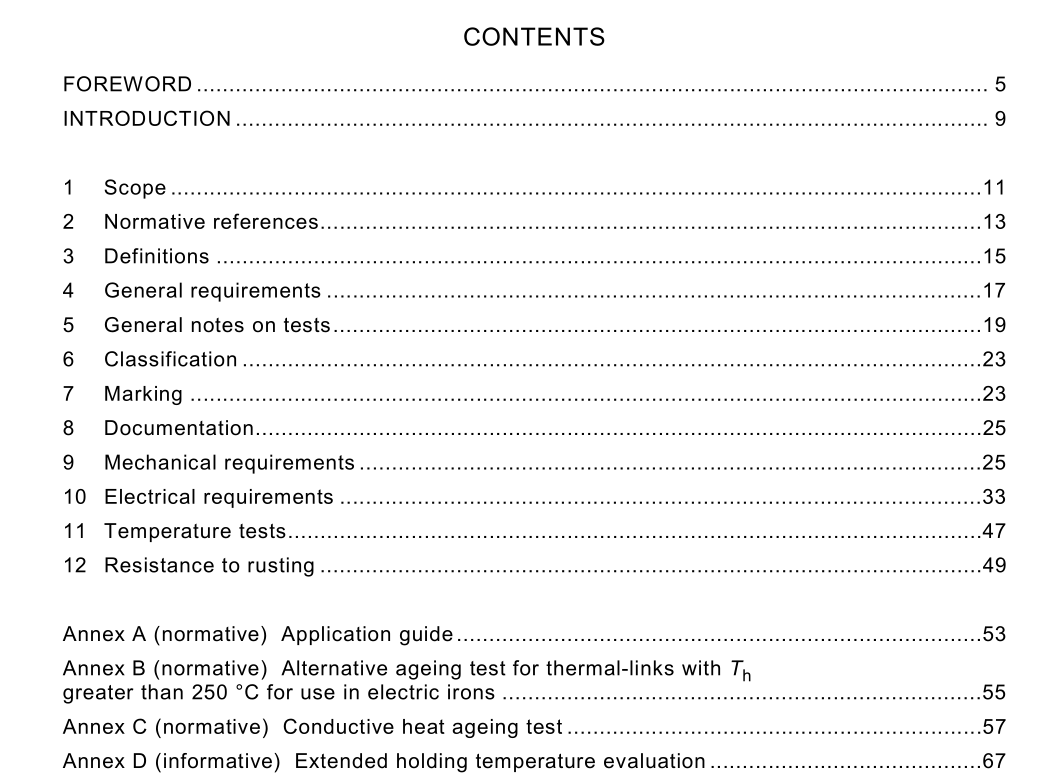IEC 60691 pdf download

IEC 60691 pdf download.Thermal-links – Requirements and application guide
1 Scope and object
This International Standard is applicable to thermal-links intended for incorporation in electrical appliances, electronic equipment and component parts thereof, normally intended for use indoors, in order to protect them against excessive temperatures under abnormal conditions. NOTE 1 The equipment need not be designed to generate heat. NOTE 2 The effectiveness of the protection against excessive temperatures logically depends upon the position and method of mounting of the thermal-link, as well as upon the current which it is carrying. NOTE 3 Attention is drawn to the fact that the external creepage distances and clearances specified in Table 3 may in some cases be smaller than those required by certain appliance or equipment standards. In such cases, additional means should be provided when a thermal-link is mounted in the equipment in order to adjust the creepage distances and clearances to the values required by the relevant equipment standard. This standard may be applicable to thermal-links for use under conditions other than indoors, provided that the climatic and other circumstances in the immediate surroundings of such thermal-links are comparable with those in this standard. This standard may be applicable to thermal-links in their simplest forms (e.g. melting strips or wires), provided that molten materials expelled during function cannot adversely interfere with the safe use of the equipment, especially in the case of hand-held or portable equipment, irrespective of its position. This standard is applicable to thermal-links with a rated voltage not exceeding 690 V a.c. or d.c. and a rated current not exceeding 63 A. The object of this standard is a) to establish uniform requirements for thermal-links, b) to define methods of test, c) to provide useful information for the application of thermal-links in equipment. This standard is not applicable to thermal-links used under extreme conditions such as corrosive or explosive atmospheres.
3 Definitions
For the purposes of this International Standard, the following definitions apply. 3.1 clearance shortest distance in air between two conductive parts 3.2 creepage distance shortest distance along the surface of insulating material between two conductive parts 3.3 holding temperature, T h maximum temperature of the thermal-link at which it will not change its state of conductivity during a specified time under specified conditions 3.4 homogeneous series (of thermal-links) series of thermal-links having common overall construction, deviating from each other only in such characteristics that, for a given test, the testing of one or a reduced number of particular thermal-links of that series shall be taken as representative for all the thermal-links of the series 3.5 interrupting current, l b value of the current that the thermal-link is capable of interrupting at rated voltage and under specified circuit conditions 3.6 maximum temperature limit, T m temperature of the thermal-link stated by the manufacturer, up to which the mechanical and electrical properties of the thermal-link, having changed its state of conductivity, will not be impaired for a given time 3.7 pilot duty class of operation in which the ultimate electrical load is controlled by an auxiliary means such as a relay or contactor 3.8 portable equipment equipment which is moved while in operation or which can easily be moved from one place to another while connected to the supply 3.9 rated current, I r current used to classify a thermal-link 3.10 rated functioning temperature, T f temperature of the thermal-link which causes it to change its state of conductivity with a detection current up to 10 mA as the only load









